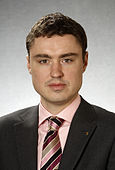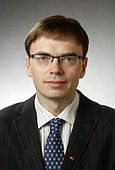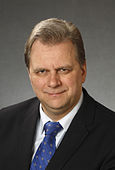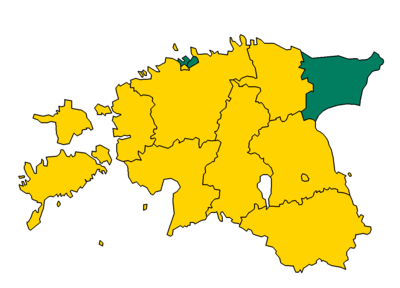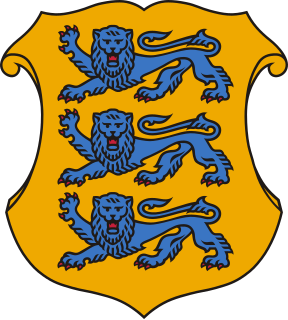
Juhan Parts is an Estonian politician who was Prime Minister of Estonia from 2003 to 2005 and Minister of Economic Affairs and Communications from 2007 to 2014. Juhan Parts is a member of the Union of Pro Patria and Res Publica party.

The Estonian Centre Party is a centrist, social-liberal, populist political party in Estonia. It is one of the two largest political parties in Estonia and currently has 26 seats in the Estonian Parliament. The Party is a member of the Alliance of Liberals and Democrats for Europe (ALDE).
Res Publica Party was a political party in Estonia that self-identified as conservative and therefore member of the International Democrat Union, but considering its vague platform for 2003 election, the genuineness of this ideology is disputed. Established as a party on 8 December 2001, the political organisation Res Publica was founded already as early as 1989 and existed as a community of young conservatives, mostly associated with the Pro Patria Union party during the 1990s. Res Publica was a member of the EPP on the European level. It merged with Pro Patria Union in 2006 to form the Pro Patria and Res Publica Union.
The Pro Patria Union was a national conservative political party in Estonia. The party was founded on 2 December 1995 from a merger of the Estonian National Independence Party and the Pro Patria National Coalition.
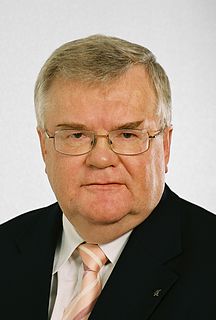
Parliamentary elections were held in Estonia on 2 March 2003. Two opposing parties won the most seats, with both the Centre Party and Res Publica Party winning 28 seats in the Riigikogu. Res Publica was able to gain enough support in negotiations after the elections to form a coalition government.
Estonia has recognised same-sex unions since January 1, 2016 by allowing same-sex couples to sign a cohabitation agreement, the first ex-Soviet state to do so.

Jüri Ratas is an Estonian politician who is the current leader of the Centre Party and the Prime Minister of Estonia. He acted as the vice-president of the Riigikogu from 2007 to 2016 and Mayor of Tallinn from 2005 to 2007. As a mayor of Tallinn he initiated the European Green Capital Award programme.

Pro Patria is a conservative political party in Estonia. It was founded on 4 June 2006 when two conservative parties, Pro Patria Union and Res Publica Party, merged. Up to the 2007 parliamentary elections, the party held 32 seats out of 101 in the Riigikogu and one of Estonia's six seats in the European Parliament. The party is a member of the European People's Party (EPP). It has about 8,500 members. The merged party consisted of two separate boards and two party leaders, which was replaced by a unified board and leader in May 2007. The party's prime minister candidate was Mart Laar, who became a chairman of the party.

Urmas Reinsalu is an Estonian politician who has been the Minister of Justice since 2015. Previously, Reinsalu has served as the Minister of Defence from 2012 to 2014. Reinsalu is a member of the Pro Patria and Res Publica Union and was party leader from 2012 to 2015.

Margus Tsahkna is an Estonian politician, former leader of the Pro Patria and Res Publica Union, former Minister of Defence in Jüri Ratas' cabinet and Minister of Social Protection in Taavi Rõivas' second cabinet.

The Estonian Free Party is an Estonian centre-right political party founded in 2014. The chairman of the party is Kaul Nurm. The party gained 8 seats after passing the 5-percent threshold in the 2015 Estonian parliamentary elections.

Parliamentary elections were held in Estonia on 3 March 2019. The Reform Party remained the largest party, gaining 4 seats for a total of 34 and the Conservative People's Party had the largest gain overall, increasing their seat count by 12 to a total of 19 seats.
An indirect election took place in Estonia in 2016 to elect the president of Estonia, who is the country's head of state. The Riigikogu — the Parliament of Estonia — elected Kersti Kaljulaid to be the next head of state of Estonia to succeed Toomas Hendrik Ilves, who had served his second and final term as president. Kaljulaid is the first female head of state of Estonia.

Jüri Ratas' cabinet is the incumbent cabinet of Estonia, in office since 23 November 2016. It is a centre-left coalition cabinet of Centre Party, Social Democratic Party and conservative Pro Patria and Res Publica Union. It was preceded by the Second Cabinet of Taavi Rõivas, a cabinet that ended when Social Democrats and the Union of Pro Patria and Res Publica joined the opposition's no confidence vote against the cabinet. This is the first time since 1999 the liberal centre-right Reform Party is out of the government.
In the run up to the 2019 Estonian parliamentary election, various organisations carry out opinion polling to gauge voting intention in Estonia. Results of such polls are displayed in this article.

